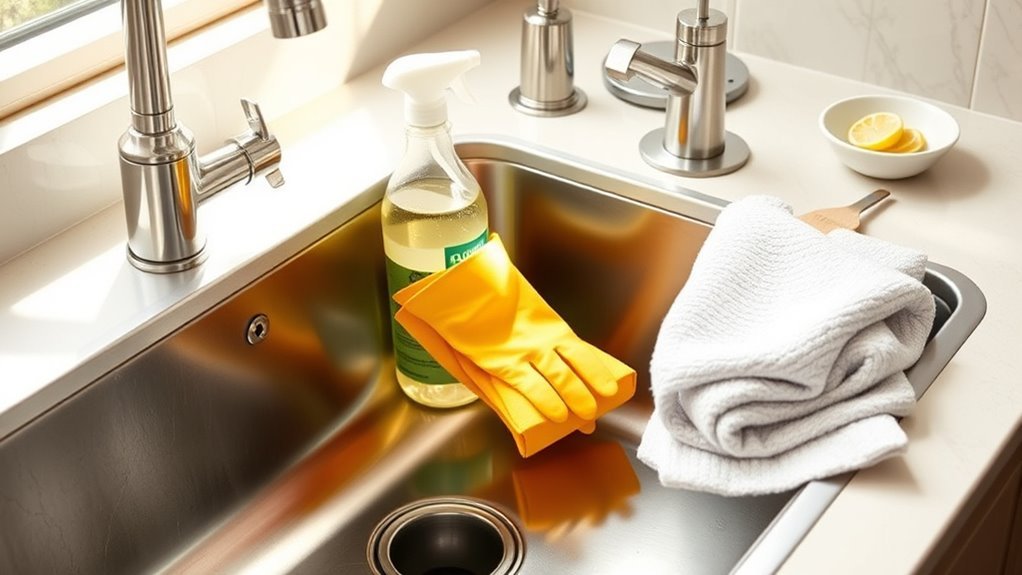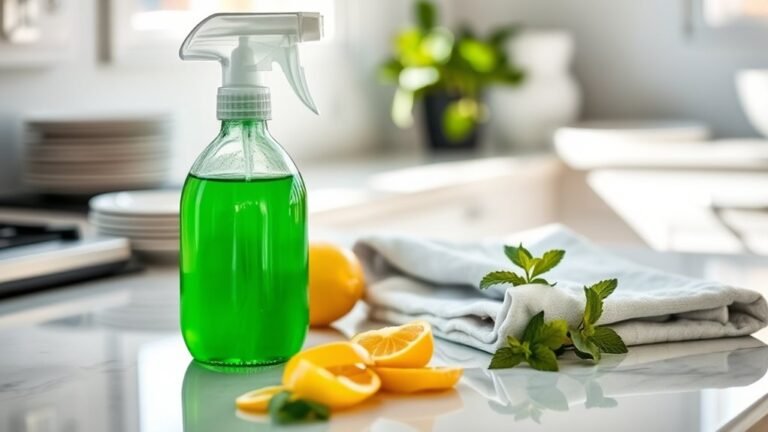How to Clean Your Sink in 10 Minutes
To clean your sink in 10 minutes, start by clearing debris and rinsing with warm water to loosen grime. Use eco-friendly cleaners and scrub gently with a soft sponge, adjusting your technique for your sink type. Rinse thoroughly, dry with a soft cloth to avoid spots, and add a fresh scent or natural polish for shine. Keeping up with quick cleanings helps maintain a hygienic, sparkling sink. Explore easy tips to keep your kitchen fresh and inviting longer.
Gather Your Cleaning Supplies

Before you begin cleaning your sink, you’ll want to gather all the necessary supplies. Having the right cleaning tools on hand saves time and lets you work efficiently, giving you more freedom to enjoy your day. Opt for eco friendly options like biodegradable sponges, natural brushes, or reusable cloths to keep your cleaning routine green and guilt-free. Choose plant-based cleaners or simple mixtures of vinegar and baking soda—they’re effective without harsh chemicals. Avoid single-use products that add waste to the environment. By preparing your eco friendly cleaning tools ahead of time, you’ll simplify the task, reduce your impact, and feel good about maintaining your space. This small step sets the tone for a quick, effective sink cleaning that respects both your time and the planet.
Clear and Rinse the Sink
Before you start cleaning, make sure to remove any debris or leftover food from the sink. Using warm water helps loosen grime and makes rinsing more effective. This simple step sets the stage for a thorough clean.
Remove Debris First
Start by clearing out any large debris from your sink, like food scraps or packaging. This simple step saves you from clogged drains and speeds up debris disposal. Keeping your sink free from leftovers is key to effective sink maintenance and allows you more freedom from unexpected plumbing hassles. Grab a trash bin or compost container and remove these bits before moving forward.
| Debris Type | Disposal Method | Maintenance Tip |
|---|---|---|
| Food Scraps | Compost or Trash | Avoid letting sit too long |
| Packaging | Recycle or Trash | Flatten to save space |
| Coffee Grounds | Trash or Compost | Use sparingly |
| Eggshells | Trash | Don’t grind in disposal |
| Vegetable Peels | Compost | Great for gardens |
Taking this step first makes your sink cleaning quick and efficient!
Use Warm Water
After clearing out debris, the next step is to use warm water to rinse your sink thoroughly. The warm water temperature is ideal because it loosens grime and dissolves leftover soap scum, making cleanup effortless. You’ll notice how warm water benefits your cleaning process by breaking down oils and residue without harsh scrubbing. This simple rinse helps free your sink from lingering dirt, leaving it fresh and ready for the next step. Plus, the warmth opens up your drain, preventing clogs and ensuring smooth water flow. By choosing warm water, you’re embracing an efficient, natural way to restore cleanliness and enjoy a sink that feels truly fresh—free from stubborn buildup and ready for anything.
Remove Food Debris and Residue

Scrape away any leftover food particles from your sink using a rubber spatula or a paper towel. This quick step clears the surface, preventing clogs and enhancing sink hygiene. Keeping your sink free from debris gives you the freedom to enjoy a clean kitchen without foul odors or mess.
Here’s how to effectively remove food debris and residue:
- Collect scraps with a spatula, directing them toward the food disposal.
- Wipe the sink basin gently with a damp paper towel or cloth.
- Rinse the sink with warm water to wash away loosened residue.
Apply the Appropriate Cleaner
Choosing the right cleaner for your sink is essential to achieving a spotless and hygienic surface. You don’t want to damage your sink by using harsh cleaning products that aren’t suited for its material. Different surface types—like stainless steel, porcelain, or granite—need specific products to stay pristine without wear. For example, gentle, non-abrasive cleaners work best on delicate surfaces, while tougher stains on metal sinks might require stronger formulas. Always check the label to confirm compatibility and avoid anything that could strip finishes or cause discoloration. By selecting the appropriate cleaner, you’re not just maintaining cleanliness—you’re protecting your sink’s longevity, giving you the freedom to enjoy a fresh, inviting kitchen space without worry.
Scrub the Sink Surface

Grab a soft sponge or cloth and start scrubbing your sink surface gently to lift away dirt and grime. Different sink materials call for different scrub techniques, so tailoring your approach guarantees you protect your sink while freeing it from buildup. For stainless steel, use a circular motion with a non-abrasive pad to avoid scratches. Porcelain sinks respond well to gentle back-and-forth scrubbing to remove stains without damage. For composite or granite sinks, a soft cloth with mild cleaner works best to preserve the surface’s integrity. Here’s a quick guide:
Tailor your scrubbing technique to your sink’s material for a spotless, scratch-free finish every time.
- Identify your sink material to pick the right scrub technique.
- Use gentle pressure to avoid wearing down finishes.
- Rinse often to see your progress and keep cleaning effective.
This method keeps your sink fresh and lets you enjoy your space without restrictions.
Clean the Faucet and Handles
Once your sink surface is sparkling clean, it’s time to turn your attention to the faucet and handles. These often-overlooked areas play a big role in faucet maintenance, keeping your whole sink looking fresh. Grab a soft cloth and a gentle cleaner—avoid harsh chemicals that could strip finishes or damage seals. Focus on handle polishing, wiping away fingerprints and water spots to restore their shine. Don’t forget to clean around the base and any crevices where grime tends to build up. Regular attention here not only boosts your sink’s appearance but also extends the life of your fixtures. Taking a few minutes for faucet maintenance now means less hassle later and more freedom to enjoy your clean, beautiful sink.
Rinse Thoroughly With Warm Water
After you’ve cleaned every part of your sink and faucet, you’ll want to rinse thoroughly with warm water to remove any remaining cleaner or residue. The right water temperature is key—it loosens grime without damaging surfaces. Choose rinse methods that suit your sink’s material and your pace, so you stay efficient and free.
Rinse your sink and faucet thoroughly with warm water to remove residue without harming surfaces.
Here’s how to rinse effectively:
- Use a steady stream of warm water to wash away loosened dirt and cleaner.
- Employ a soft cloth or sponge under running water to reach corners and edges.
- Tilt the sink slightly if possible, letting water carry away debris naturally.
Wipe Down and Dry the Sink
Pat your sink dry with a soft cloth to prevent water spots and streaks. This simple step is essential for effective sink maintenance, helping you keep your sink looking polished and fresh without extra effort. Use a microfiber or cotton cloth—these materials absorb moisture quickly and won’t scratch the surface. When wiping down, focus on all the edges and corners where water tends to collect. Employing proper drying techniques not only improves the sink’s appearance but also reduces the chance of mineral buildup and mold growth. By making this quick wipe-down part of your routine, you’re choosing freedom from constant deep cleaning while preserving your sink’s shine and hygiene with minimal fuss. It’s a small habit that pays off big in the long run.
Add a Fresh Scent or Polish
Enhance your sink’s appeal by adding a fresh scent or polish. This final touch not only brightens your sink but also leaves your space feeling revitalized. Here’s how you can do it quickly and naturally:
Add a fresh scent or natural polish to brighten your sink and refresh your space effortlessly.
- Choose scented oils like lavender or eucalyptus—just a few drops on a cotton ball placed near the drain will infuse your sink area with a invigorating aroma.
- Use a natural polish made from ingredients like olive oil and lemon juice to restore shine without harmful chemicals.
- Apply the polish using a soft cloth, buffing gently to bring out a smooth, glossy finish that protects your sink from water spots.
Frequently Asked Questions
How Often Should I Deep Clean My Sink?
You should do daily cleaning to keep your sink fresh and free from grime, preventing buildup that can cause odors or stains. For deeper care, weekly maintenance is key—it tackles hidden gunk and keeps your sink sparkling. Sticking to this routine gives you freedom from tough scrubbing later and guarantees your sink stays hygienic and inviting, so you can enjoy your kitchen without worrying about mess or germs.
What Are the Best Natural Cleaners for a Sink?
Like a trusty sidekick in your cleaning adventures, natural cleaners make your sink sparkle without harsh chemicals. You’ll want to reach for baking soda to scrub away grime, then splash a vinegar solution to fizz away stains. Lemon juice adds a fresh zing, while a few drops of essential oils bring a rejuvenating scent that frees your space from dullness. These simple ingredients let you clean with peace and power.
Can I Use Bleach to Clean My Sink?
You can use bleach to clean your sink, but you’ve got to take into account bleach safety and the type of sink materials you have. Bleach works great on stainless steel and porcelain, but it can damage natural stone or colored surfaces. Always dilute it properly and ventilate the area well. Wearing gloves protects your skin, too. If you want freedom from harsh chemicals, natural alternatives might give you peace of mind while keeping your sink spotless.
How Do I Prevent Sink Stains From Forming?
Did you know that 60% of people neglect sink care, leading to stubborn stains? To prevent sink stains, you need to take preventive measures like wiping down your sink daily and avoiding letting water sit. Regular maintenance, such as using mild cleaners and drying the surface after each use, keeps stains at bay and gives you the freedom to enjoy a spotless sink without hassle. Consistency is key!
What Should I Do if My Sink Is Clogged?
If your sink is clogged, don’t stress! Start by using a plunger or a drain snake to gently clear the blockage. For easy sink maintenance and clog prevention, regularly flush your drain with hot water and avoid pouring grease or food scraps down it. Keeping those habits will give you the freedom to enjoy your kitchen without constant sink troubles, saving time and hassle in the long run.






